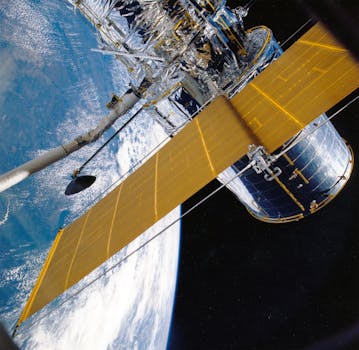GEO Satellites: Understanding the Technology and Applications of Geostationary Orbit Satellites

GEO Satellites: Introduction to Geostationary Orbit Satellites
GEO satellites, short for Geostationary Orbit satellites, are a type of satellite that orbits the Earth at an altitude of approximately 36,000 kilometers above the equator. At this height, the satellite’s orbital period matches the Earth’s rotational period, allowing it to remain stationary relative to a fixed point on the Earth’s surface. This unique characteristic makes GEO satellites ideal for a wide range of applications, including telecommunications, weather forecasting, and space exploration.
The concept of GEO satellites was first proposed by science fiction writer Arthur C. Clarke in 1945. However, it wasn’t until the 1960s that the first GEO satellite, Syncom 2, was launched into space. Since then, hundreds of GEO satellites have been launched, providing vital services to people around the world.
How GEO Satellites Work

GEO satellites work by using a combination of propulsion systems and gravity to maintain their orbit. The satellite is first launched into a geostationary transfer orbit, which is an elliptical orbit that takes the satellite from the Earth’s surface to the geostationary orbit. Once in the geostationary orbit, the satellite uses its propulsion system to circularize its orbit and maintain its position.
GEO satellites use a variety of instruments and antennas to perform their designated functions. For example, telecommunications satellites use large antennas to transmit and receive signals, while weather satellites use specialized instruments to monitor the Earth’s atmosphere and oceans. The data collected by GEO satellites is then transmitted back to Earth, where it is used for a wide range of applications.
Applications of GEO Satellites

GEO satellites have a wide range of applications, including telecommunications, weather forecasting, and space exploration. Telecommunications satellites use GEO satellites to provide internet, television, and phone services to people around the world. Weather satellites use GEO satellites to monitor the Earth’s atmosphere and oceans, providing vital data for weather forecasting and climate modeling.
In addition to these applications, GEO satellites are also used for space exploration. For example, the Hubble Space Telescope, which is in a geostationary orbit, has been used to study the universe in unprecedented detail. Other GEO satellites have been used to study the Earth’s magnetic field, the solar wind, and the Earth’s atmosphere.
Future Prospects of GEO Satellites

Despite the many advantages of GEO satellites, there are also challenges and limitations to their use. One of the main challenges is the increasing amount of space debris in the geostationary orbit, which can pose a risk to operational satellites. Additionally, the geostationary orbit is a limited resource, and there is a growing need for more satellites to meet the increasing demand for telecommunications and other services.
However, researchers and engineers are working to develop new technologies and strategies to overcome these challenges. For example, the development of new propulsion systems and materials is expected to improve the efficiency and sustainability of GEO satellites. Additionally, the use of smaller satellites and constellations is expected to provide more flexibility and capacity for telecommunications and other applications.
See more:






